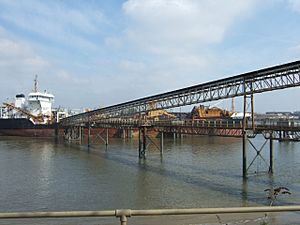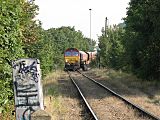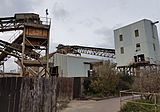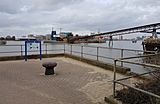Angerstein Wharf facts for kids
Quick facts for kids Angerstein Wharf |
|
|---|---|
 A ship at Angerstein Wharf |
|
| London borough | |
| Ceremonial county | Greater London |
| Region | |
| Country | England |
| Sovereign state | United Kingdom |
| Post town | LONDON |
| Postcode district | SE7 |
| Dialling code | 020 |
| Police | Metropolitan |
| Fire | London |
| Ambulance | London |
| EU Parliament | London |
| London Assembly |
|
Angerstein Wharf is a busy industrial area in London. It's located right on the River Thames. This wharf is a key place for handling building materials. These materials include things like sand and gravel, known as "construction aggregates." It also has a facility for cement and a freight station. The company Cemex operates the wharf. You can find it in both Greenwich and Charlton. Both areas are part of the Royal Borough of Greenwich. Angerstein Wharf is very important. It has "safeguarded wharf" status. This means it is protected for industrial use.
Contents
History of Angerstein Wharf
The wharf got its name from John Julius Angerstein (1732–1823). He was a rich local landowner. He made his money from trade. Angerstein also had a famous art collection. This collection was later bought to start the National Gallery, London.
Building the Railway Line
John Julius Angerstein built a railway line. It was about 1 mile (1.6 km) long. This line connected the wharf to the main railway. The main line ran from Blackheath to Charlton. When it was first built, the railway junction faced Blackheath. Today, the junction faces Charlton station.
The South Eastern Railway leased this branch line. They leased it from 1852 until 1898. Then, they bought it completely. The railway company also set up its signal works here. This area was called the Angerstein Triangle. The signal works closed around the early 1980s.
When the wharf first opened, it had a long riverfront. It was about 755 feet (230 meters) long. It could handle ships weighing up to 1,500 tons.
Past Industries at the Wharf
Many different businesses operated at Angerstein Wharf over the years.
- Dredging: From 1820 to 1930, Flowers and Everett worked here. They were dredging contractors. They used a narrow-gauge railway system.
- Steel: Two steel companies operated on the site. Redpath Dorman Long was there from 1903 to 1978. Greenwich Metal Works operated from 1913 to 1976. Both companies used their own small trains.
- Glass: A large glass bottling factory was also here. It was run by United Glass Bottle Manufacturers. This factory operated from 1919 to 1967.
Other important facilities were also nearby.
- Tram Depot: The London County Council had a tram repair depot. It opened in 1909. A railway siding served this depot.
- Gasworks: The South Metropolitan Gas Company opened a large gasworks in 1886. This was the East Greenwich Gas Works. It stopped making coal gas in 1968. Today, the Millennium Dome is on this site. The gasworks had its own trains.
- Timber: A company called Christies supplied railway sleepers. These are the wooden blocks that support railway tracks. They had a large internal rail network. By 1925, they produced many sleepers and telegraph poles.
The wharf also handled many other goods. These included steel, coal, stone, sand, and timber.
Passenger Trains at the Wharf
Angerstein Wharf was mainly for freight. Passenger trains were very rare here. They were usually special trips for railway enthusiasts. For example, a special train ran on March 29, 1958. Other special trains, like 'The Blue Circular' and 'Orange Pippin', also used the line in later years.
Later Developments
In the 1970s, Angerstein Wharf was used for a big project. Large stone boulders arrived by train from Staffordshire. These stones were used to build the Thames Barrier. This barrier protects London from floods.
From 1963 to 1987, Thames Metal Company ran a scrap yard here. In 1993, Day Aggregates took over this site. This is where the current facility is located.
Current Use of Angerstein Wharf
Since 1990, Angerstein Wharf has been used mostly for one purpose. It loads and unloads "sea-dredged aggregates." These are materials like sand and gravel. They are collected from the seabed. As of 2014, Aggregate Industries operated the site.
The Thames Path runs right past Angerstein Wharf. You can see several conveyors moving materials over the path. Sometimes, there is dust from cement and sand on parts of the path.
-
Conveyors handling cargoes of bulk aggregate, 2010
See also
- Charlton Riverside
- Port of London
- Thames Path







